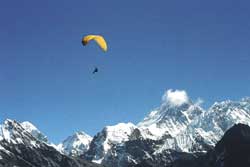 Contrary to predictions of a serious shortfall in tourists this season after the breakdown of the ceasefire, October has seen a rebound in trekking traffic-especially in the Khumbu.
Contrary to predictions of a serious shortfall in tourists this season after the breakdown of the ceasefire, October has seen a rebound in trekking traffic-especially in the Khumbu.
Despite an initial spate of cancellations in August, most trekking agencies and tour operators are surprised by the rebound and attribute it partly to the publicity of the Golden Jubilee Anniversary fanfare of the first Everest ascent in May. Tourist arrivals by air in October soared 41 percent compared to the same month last year, and it is actually difficult to get airline seats into Kathmandu and inside Nepal.
"Tourists coming to Nepal have the attitude there are now very few adventure destinations in the world that are considered safe," says Wanda Vivequin who leads mainly New Zealander trekkers to Nepal. "One of my clients said to me that if they took note of every single travel warning being issued by their embassy these days, they would probably never even leave their own home town."
Most trekkers this season have concentrated on the Everest and Annapurna region, and after reports of extortion on the Annapurna circuit many decided to go to Khumbu. "Everyone flew to Lukla and headed up, because the Everest region is considered safe," explains Padam Ghale of Mandala Treks. There were more than 2,000 trekkers entering the Sagarmatha National Park last month alone.
 Even in Maoist-affected areas, trekking groups have not been affected because the guides have an understanding with local comissars about 'war tax'. In Makalu, trekkers pay a fixed rate of Rs 5,000 per trekker, Rs 1,500 per sardar and Rs 500 per porter. In Simikot, the Maoists demand $100 per entry. In the Annapurnas it is Rs 1,000 per trekker. (See 'Letter to a young Maoist', #168)
Even in Maoist-affected areas, trekking groups have not been affected because the guides have an understanding with local comissars about 'war tax'. In Makalu, trekkers pay a fixed rate of Rs 5,000 per trekker, Rs 1,500 per sardar and Rs 500 per porter. In Simikot, the Maoists demand $100 per entry. In the Annapurnas it is Rs 1,000 per trekker. (See 'Letter to a young Maoist', #168)
The turnover this season seems to have more to do with intensive PR work by travel and trekking agencies with individual clients than any campaign mounted by Nepal Tourism Board (NTB). "We give it straight to our clients about potential risks, and let them decide," says Ghale. The honesty seems to have paid off.
Vivequin agrees: "I haven't had a single client cancel a trip with me in the last three years out of fear of coming to Nepal, largely because I have been able to put the conflict into some sort of context. In my home country of Canada, I often find myself going to great lengths to try and explain to people that in so many ways you have a greater chance of being run over by a bus or a car at home than you have of being harmed by the conflict in Nepal."
 Last month there were up to 300 trekkers a day doing the Annapurna circuit, slightly lower than normal autumn figures. Even though the Annapurnas have always got more trekkers than Everest, news of security concerns there have acted as a deterrent. "Agencies take a risk when we send people there, paying as much as Rs 1,000 per trekker," says Ganesh Bhattarai, owner of Pub Amsterdam and Boomerang Restaurant at Pokhara's lakeside. "We give trekkers the most reliable and recent information and let them decide." Here too, presenting the truth seems to have played a vital role in convincing tourists to visit Nepal.
Last month there were up to 300 trekkers a day doing the Annapurna circuit, slightly lower than normal autumn figures. Even though the Annapurnas have always got more trekkers than Everest, news of security concerns there have acted as a deterrent. "Agencies take a risk when we send people there, paying as much as Rs 1,000 per trekker," says Ganesh Bhattarai, owner of Pub Amsterdam and Boomerang Restaurant at Pokhara's lakeside. "We give trekkers the most reliable and recent information and let them decide." Here too, presenting the truth seems to have played a vital role in convincing tourists to visit Nepal.
Honesty is a tourism policy that seems to be working, at least for now. But it won't last if things here continue to slide.


